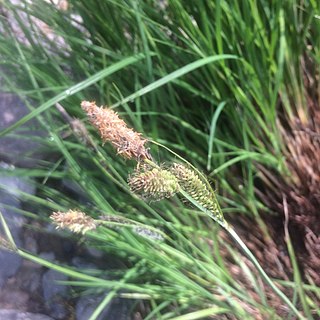
Carex nudata is a species of true sedge known by several common names, including torrent sedge, California black-flowering sedge, Dudley's sedge, and naked sedge.

Dulichium is a monotypic genus of sedge containing the single species Dulichium arundinaceum, which is known by the common name threeway sedge. This is an aquatic or semi-aquatic plant of the lakes, streams, and ponds of the United States and Canada It has a wide distribution across the two countries, though noticeably absent from the Dakotas and from the Southwestern Deserts.
Carex amplifolia is a species of sedge known by the common name bigleaf sedge. It is native to western North America from British Columbia to Montana to California, where it grows in wet and seasonally wet areas in coniferous forests.

Carex buxbaumii is a species of sedge known as Buxbaum's sedge or club sedge. It is native to much of the northern Northern Hemisphere, from Alaska to Greenland to Eurasia, and including most of Canada and the United States. It grows in wet habitat, such as marshes and fens. This sedge grows in clumps from long rhizomes. The stems are 75–100 cm (30–39 in) in maximum height. The leaves are narrow and small. The inflorescence has a bract which is sometimes longer than the spikes. The fruits have dark-colored bracts and a sac called a perigynium or utricle which is gray-green and rough in texture.

Carex filifolia is a species of sedge known by the common name threadleaf sedge. It is native to western North America and grows on slopes, eroded areas, gravel, and dry habitats.

Carex hassei is a species of sedge known by the common name salt sedge. It is native to western North America from British Columbia to Baja California to New Mexico, where it grows in moist places, such as meadows.
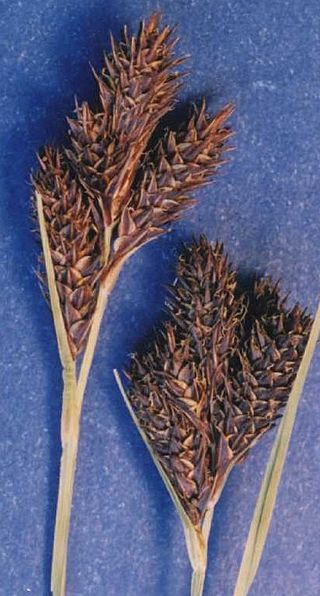
Carex helleri is a species of sedge known by the common name Heller's sedge. It is native to eastern California and western Nevada, where it grows on rocky mountain slopes and in other habitats.

Carex illota is a species of sedge known by the common name sheep sedge. It is native to western North America, where it grows in wet places such as marshes and mountain meadows, from New Mexico and California north to Western Canada.

Carex leptalea is a species of sedge known by the common names bristly-stalked sedge and flaccid sedge. It is native to much of North America including most of Canada, the Dominican Republic, and the United States. It only grows in wetlands. This sedge produces dense clusters of thin stems up to 70 centimeters tall from a network of branching rhizomes. The thin, deep green leaves are soft, hairless, and sometimes drooping. The inflorescence is up to 16 millimeters long but only 2 to 3 millimeters wide, and is yellow-green in color. There are only a few perigynia on each spikelet, and they are green and veined.
- Carex leptalea subsp. harperi(Fernald) W.Stone - southeastern US from Texas and Florida north to Missouri and Pennsylvania
- Carex leptalea subsp. leptalea - widespread from Alaska east to Nunavut and south to California and Dominican Republic
- Carex leptalea subsp. pacificaCalder & Roy L.Taylor - Washington State, British Columbia, southeastern Alaska
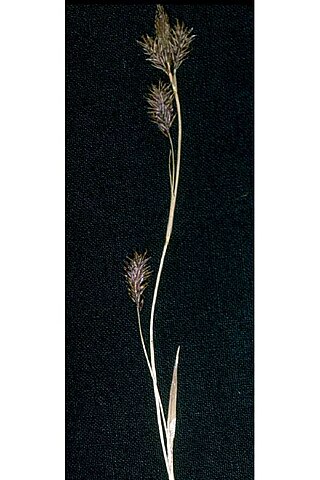
Carex luzulina is a species of sedge known by the common name woodrush sedge.
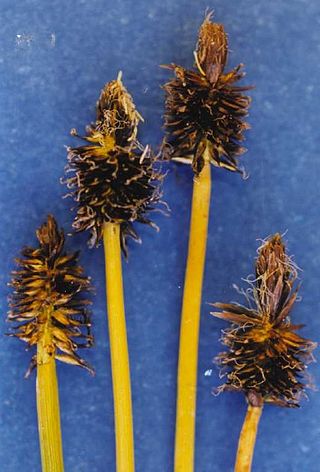
Carex nigricans is a species of sedge known by the common name black alpine sedge.

Carex obnupta is a species of sedge known by the common name slough sedge. It is native to western North America from British Columbia to California where it grows abundantly in wet, often saline habitat such as wetlands. The plant produces upright, angled stems approaching 1.2 meters in maximum height, growing in beds or colonies from rhizome networks. The inflorescence is a cluster of flower spikes accompanied by a long leaflike bract. The pistillate spikes and sometimes the staminate spikes dangle on peduncles. The fruit is coated by a hard, tough, shiny perigynium which is generally dark in color.
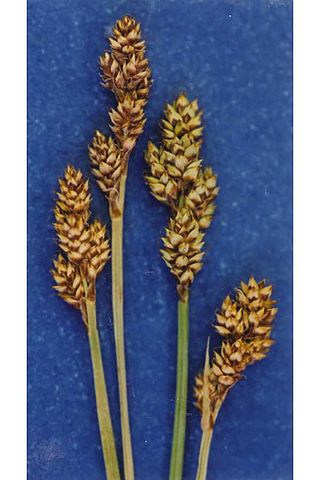
Carex praeceptorum is a species of sedge known by the common names early sedge and teacher's sedge.

Carex praegracilis is a species of North American sedge known as clustered field sedge, field sedge, and expressway sedge. Carex praegracilis is cultivated in the specialty horticulture trade as lawn substitute and meadow-like plantings.
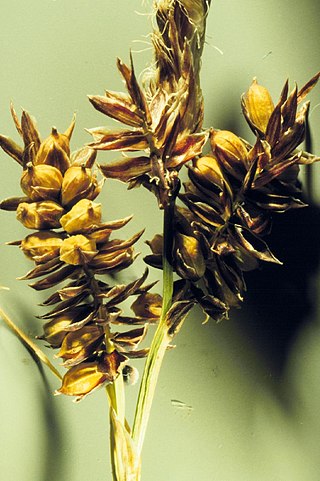
Carex raynoldsii is a species of sedge known by the common name Raynolds' sedge. It is native to western North America and grows in alpine to subalpine meadows.

Carex rossii, commonly known as Ross's sedge, is a hardy species of sedge that is often a pioneer species in areas with little or no established vegetation, or in places where disturbance has occurred. Ross's sedge grows in a variety of habitats throughout much of western North America, from Alaska to Ontario, south to New Mexico and California. It flowers in May and June.
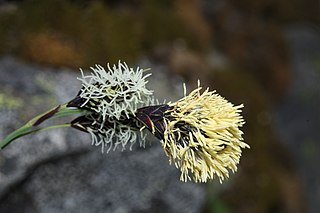
Carex spectabilis is a species of sedge known by the common name showy sedge.
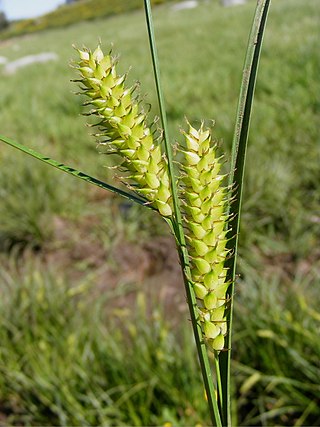
Carex vesicaria is an essentially Holarctic species of sedge known as bladder sedge, inflated sedge, and blister sedge. It has been used to insulate footwear in Norway and among the Sami people, and for basketry in North America.
Carex lemmonii, or Lemmon's sedge, is a plant in the sedge family, and is endemic to California. Carex albida is now considered a synonym, but was previously thought to be a separate species; such plants have the common name white sedge.

Carex capillaris, the hair-like sedge, is a species of sedge found in North America and northern Eurasia including Greenland.


















